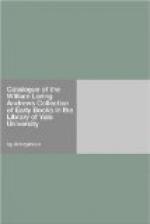Folio. Sign. a-b^{10}, c-d^8, e^{10}, f^8, g^{10}, h^8, i^{10}, k^8, l-t^{10}, u^8, x^{10}, aa-dd^{10}, ee^8, ff^6. 252 leaves, the first and the last blank, roman letter, 35 lines to the page, without pagination. Two- to seven-line spaces left for initials, with guide-letters. Hain 1699. Proctor 4312. Morgan Cat., II, p. 48, n. 313. Burger pl. 199.
The border surrounding the first page of text, and eighteen initials of the several books, are illuminated in gold and colors. Chapter initials supplied in red and blue alternately.
Printed signatures, which appear to have been first introduced by Zarotto of Milan in 1470, and a register of sheets, first used by John of Cologne in 1475, are both found in this volume. The register, which may give only the number of sheets in each of the quires, or the first word of each sheet of the quire, is here of the latter kind. Unfortunately two sheets escaped registration and the words are supplied in manuscript.
Three separate treatises of Aristotle are contained in this volume: Historia de animalibus libri ix; De partibus animalium libri iv; De generatione animalium libri v.
Theodore Gaza, the translator, was a learned Greek from Thessalonica, who took up his residence in Italy on the capture of his native city by the Turks. The translation was made at the instance of Nicolas V., who had invited him to Rome in 1450, but was first printed in the present edition (Venice, 1476) and dedicated in a flattering epistle of eleven pages to the reigning pope, Sixtus IV. The fifty scudi which the pope sent in acknowledgment of the dedication copy Gaza is said to have thrown in disgust into the Tiber. It is interesting to note in this connection that while the Venice editions of 1492 and 1498 retain the name of Sixtus IV. in the dedication, Aldus after having omitted the epistle altogether in his 1504 edition, in that of 1513 quietly substituted the name of Nicolas V., the earlier and worthier patron, without a word of change in the language of the dedication itself. Later editions have followed the example of Aldus.
John of Cologne, established as a printer at Venice as early as 1471, was associated 1472-1473 with Wendelin of Speier, whose business and types he took over in 1474. He had as partner, 1474-1480, John Manthen, and in 1480, Nicolas Jenson. The type of the Aristotle is a close imitation of the first font of John and Wendelin of Speier.
The Wodhull copy, bought at the Pinelli sale for L2.12s.6d. Bound in hf. vellum. Leaf 12 x 8-1/4 in.
15. UBERTINUS DE CASALI. Arbor vitae crucifixae
Jesu. Venetiis, Andreas
de Bonetis de Papia, 12 March,
1485.




